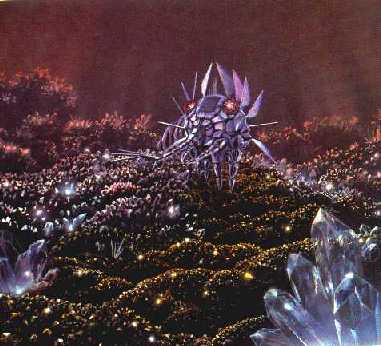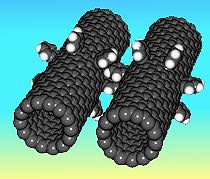The
Nature of Life
The life as we know it is the one that exists over the surface of our
planet and, possibly, may also exist in the Jupiterís satellite Europa or even in Mars
Ė life based on the carbon element (C) and using the water (H2O) as
the solvent.
Titan: Ethane and Methane
However, nothing tells us that this is the only possible life form. On
the Saturnís satellite Titan, where the methane (CH4)
assumes the role that water does on Earth (existing under gaseous, liquid and
solid states and falling on the ground under the form of rain), a primitive
chemistry is being developed. But, given the slowness of the reactions (because
the low temperatures Ė about Ė180 ļC or 90 ļK Ė determine so), it hasnít yet
overtaken the pre-biotic state, even when 4500 million years have already
elapsed since the beginning of its existence.
Nevertheless, there can be found there uncountable organic molecules, like
the hydrocarbons (ethane, propane, acetylene, etc) and nitrogen composites
(hydrogen cyanide, cyanoacetylene, etc). Itís probable that Titan is covered by ethane and methane oceans, where many of those molecules,
namely the hydrocarbons, may be found dissolved.

Profile of the atmosphere
of Titan (University of Michigan)
Ammonia and Other Solvents
Other solvents could also serve as a base for the emergence of life
forms, as the alcohol or the ammonia. The ammonia melts at a higher temperature
than the methane and, therefore, it could harbour life forms in planets with
higher temperature planets, more favourable to quicker reactions.
Itís thought, nevertheless, that the existence of organisms in such
environments is less probable than in the water, because this is the most
abundant solvent and it has a great ability to concentrate solid elements at
its edges.
Silicon and Germanium
Life can also be based in molecules other than carbon. Silicon and germanium are
candidates to that role, because they allow the formation of polymers, which
are long molecular chains that are the base of the life.
However, carbon is much more abundant in the Universe than silicon and
amazingly more abundant than germanium. Besides that, silicon forms excessively
strong links with the oxygen, which prevents it from having the required
versatility for the metabolic reactions, which are based on the constant
formation and breaking of links inside the environment of a living cell.
A Lithovore
One hypothetical form of life based on silicon would resemble more a
crystal than any plant or animal that is known on Earth. Something similar to a
robotic insect would feed from rocks and would live under a very dense and
thick atmosphere (far above the boiling point of water). The atmospheric
pressure would be very powerful Ė the air would weigh there more than a
terrestrial ocean at a deepness of several thousands of metres. A crystal-like
vegetation would grow constantly over the surface of such planet, feeded by the
lava flows.
The tweezers of a lithovore (silicon creature that is feeded by stone)
would have the power to break and grind the crystal rock in order to ingest it
more easily. Hard minerals could be melted or dissolved through jets of strong
acids. The lithovoreís life is based on the electric energy generated by an
internal reactor and, therefore, itís important that they are endowed with
tools (like the Geiger counters) that allow them to find radioactive minerals. Itís also possible that they
are a sub-surface species, spending most of their lifes excavating, breeding
and hunting in complex nets of tunnels.
The lithovores are not born like us. They are manufactured by a
"queen" (as in the case of the termites or the bees), which looks
much more like a factory than like a living creature.

Lithovore (Adolf Schaller)
Macronuclear Life
Life may not even be based on molecular matter, as we know it. Itís
possible that on the crushing surfaces of the neutron stars there are creatures based
on a macronuclear chemistry, in which complex and gigantic structures of
neutrons have the same role as the molecules (structures of atoms) have on Earth. Such creatures would be microscopical and, because
their vital functions would be processed at the light speed, they wouldnít probably have life
expectancies higher than a fraction of a second. Even if we visited them, they
wouldnít see us as life forms, since we would look like being frozen in time.
The Black Cloud
It may also be conceived a creature living in the inter-stellar space, where
it would nearly face no limitations concerning to its size, because the gravity
force is very dimly felt there. So, such a creature should be huge (measuring
several kilometres), in order to be able to filter a sufficient quantity of the
scarce dust (the interstellar space
is almost empty) and light photons (the interstellar space
is cold and dark as a new moonís night) that it would meet in itís path. Even
the low energy levels that are necessary to keep the metabolism require giant
collecting panels, analogue to the solar panels.
In the interstellar space such creatures could be extremely thin,
because they would seldomly collide with whatever. The fact that they are so
thin would reduce their mass to minimum values and, that way, their needs for
matter and energy would be limited. However, they would have to preserve a
minimum consistence so they wouldnít become disrupted in space, the only
environment where their existence would be possible. Itís noticeable that one
of these creatures would immediately collapse if it was faced with the
terrestrial atmospheric pressure and gravity.
The movement of these creatures in space could be entirely passive, like
the plankton adrift in an ocean. On the other hand, it can be imagined a
creature that would need to be transported in the direction of the energy and
matter sources (used during its growth). However, that behaviour would require
higher matter and energy consumption, which could be revealed to be strong
barriers against the feasibility of such a way of life, precisely due to the
big distance between such sources. It is, therefore, unlikely that such living
creatures actually exist.
Artificial Life
Finally, we can mention some ideas about artificial living creatures. In
the future, the humanity may create entirely artificial brains that will
replace the biological tissues through the use of nanotechnology (technological
manipulation at an atomic or molecular scale). Thatís what already happens with
the computers with which we are familiarized today, although at a still quite
modest level.
If our brain could achieve the thinking speed (information processing
speed) of these machines, we would become far more intelligent and we would
have the perception of the world at a much slower motion that we have today (a
half minute would look so long as a year).
If some day we achieve to create artificial brains, we finally may be
able to get rid of the biological restrictions, to increase our lifesí
expectancies (perhaps close to immortality) and to endow ourselves with
prodigious capacities.

Nanotechnology: microscopical
engine (Nanotechnology magazine)
_